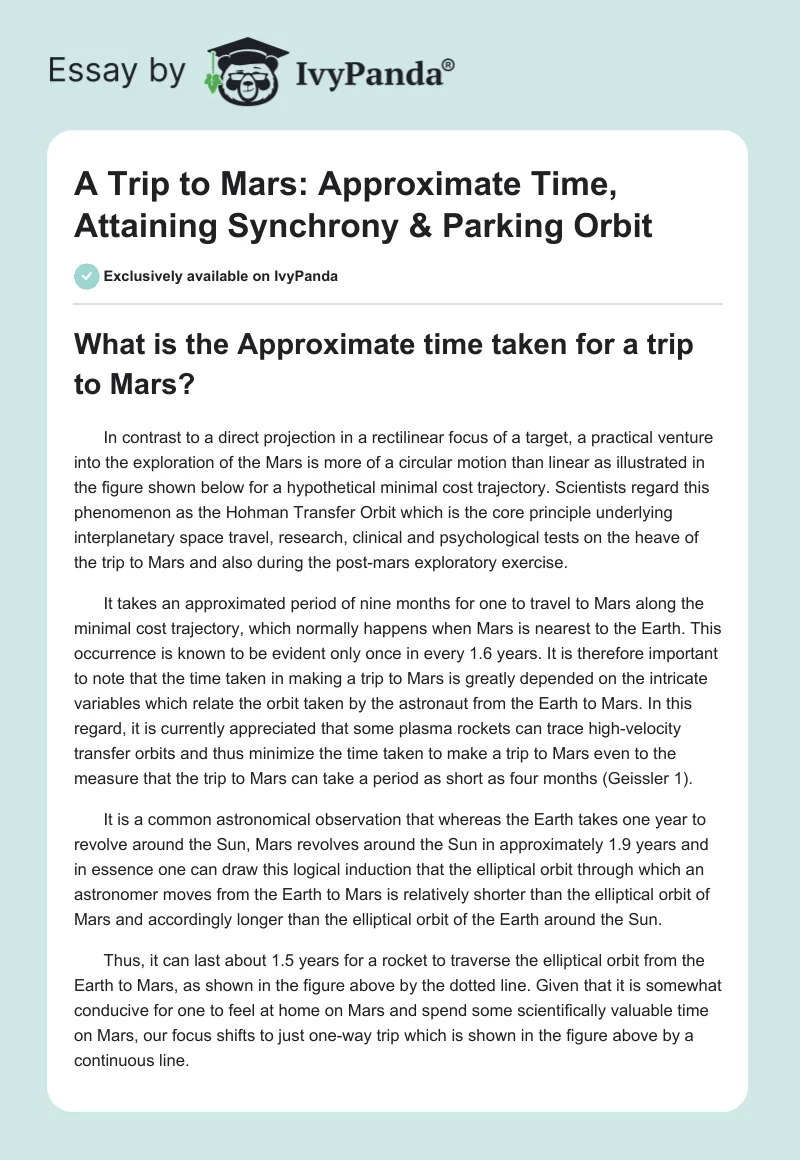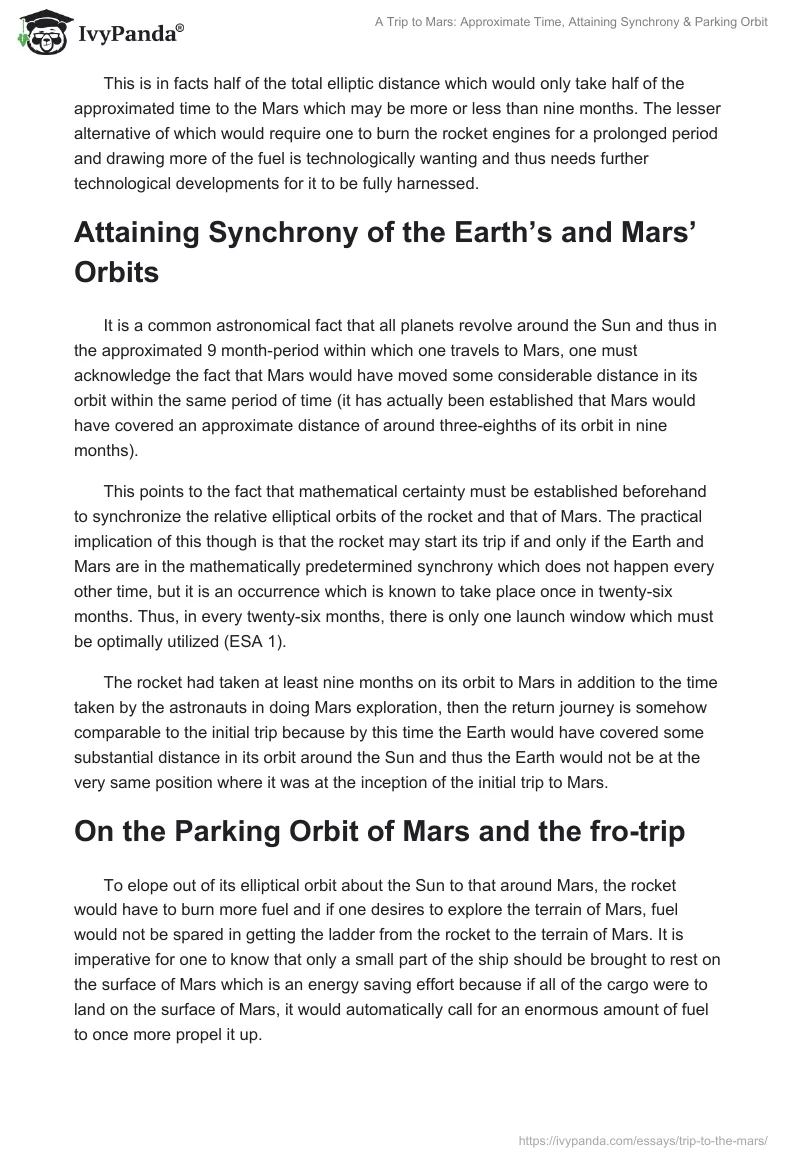What is the Approximate time taken for a trip to Mars?
In contrast to a direct projection in a rectilinear focus of a target, a practical venture into the exploration of the Mars is more of a circular motion than linear as illustrated in the figure shown below for a hypothetical minimal cost trajectory. Scientists regard this phenomenon as the Hohman Transfer Orbit which is the core principle underlying interplanetary space travel, research, clinical and psychological tests on the heave of the trip to Mars and also during the post-mars exploratory exercise.
It takes an approximated period of nine months for one to travel to Mars along the minimal cost trajectory, which normally happens when Mars is nearest to the Earth. This occurrence is known to be evident only once in every 1.6 years. It is therefore important to note that the time taken in making a trip to Mars is greatly depended on the intricate variables which relate the orbit taken by the astronaut from the Earth to Mars. In this regard, it is currently appreciated that some plasma rockets can trace high-velocity transfer orbits and thus minimize the time taken to make a trip to Mars even to the measure that the trip to Mars can take a period as short as four months (Geissler 1).
It is a common astronomical observation that whereas the Earth takes one year to revolve around the Sun, Mars revolves around the Sun in approximately 1.9 years and in essence one can draw this logical induction that the elliptical orbit through which an astronomer moves from the Earth to Mars is relatively shorter than the elliptical orbit of Mars and accordingly longer than the elliptical orbit of the Earth around the Sun.
Thus, it can last about 1.5 years for a rocket to traverse the elliptical orbit from the Earth to Mars, as shown in the figure above by the dotted line. Given that it is somewhat conducive for one to feel at home on Mars and spend some scientifically valuable time on Mars, our focus shifts to just one-way trip which is shown in the figure above by a continuous line.
This is in facts half of the total elliptic distance which would only take half of the approximated time to the Mars which may be more or less than nine months. The lesser alternative of which would require one to burn the rocket engines for a prolonged period and drawing more of the fuel is technologically wanting and thus needs further technological developments for it to be fully harnessed.
Attaining Synchrony of the Earth’s and Mars’ Orbits
It is a common astronomical fact that all planets revolve around the Sun and thus in the approximated 9 month-period within which one travels to Mars, one must acknowledge the fact that Mars would have moved some considerable distance in its orbit within the same period of time (it has actually been established that Mars would have covered an approximate distance of around three-eighths of its orbit in nine months).
This points to the fact that mathematical certainty must be established beforehand to synchronize the relative elliptical orbits of the rocket and that of Mars. The practical implication of this though is that the rocket may start its trip if and only if the Earth and Mars are in the mathematically predetermined synchrony which does not happen every other time, but it is an occurrence which is known to take place once in twenty-six months. Thus, in every twenty-six months, there is only one launch window which must be optimally utilized (ESA 1).
The rocket had taken at least nine months on its orbit to Mars in addition to the time taken by the astronauts in doing Mars exploration, then the return journey is somehow comparable to the initial trip because by this time the Earth would have covered some substantial distance in its orbit around the Sun and thus the Earth would not be at the very same position where it was at the inception of the initial trip to Mars.
On the Parking Orbit of Mars and the fro-trip
To elope out of its elliptical orbit about the Sun to that around Mars, the rocket would have to burn more fuel and if one desires to explore the terrain of Mars, fuel would not be spared in getting the ladder from the rocket to the terrain of Mars. It is imperative for one to know that only a small part of the ship should be brought to rest on the surface of Mars which is an energy saving effort because if all of the cargo were to land on the surface of Mars, it would automatically call for an enormous amount of fuel to once more propel it up.
In this manner, therefore, part of the ship must be left in the parking orbit of Mars as well as part of the crew attends to the business of exploring the surface of Mars. In the same manner in which the launch of the rocket awaits the synchrony of the Earth and Mars orbits for the to-trip, so does the fro-trip during which synchrony must be established before the rocket starts its way back to the Earth (Astronomer 1).
Works Cited
Astronomer. “How long would a trip to Mars take?” Ask the Astronomer. (2011). Web.
ESA. “Life after Mars”. Esa’s Participation in Mars500: Human space lift. (2012). Web.
Geissler, Paul. “The serpent Dust Devil of Mars”. High resolution imaging science experiment, the University of Arizona. (2012). Web.


